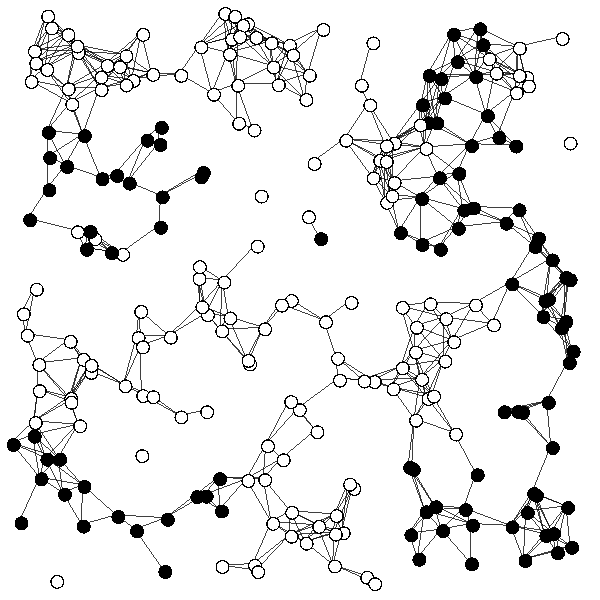What is a liquid brain?
Our paper addresses this question by presenting the simplest model of a liquid brain we can think of. Inspired by the simplicity and power of cellular automata we created Liquid Cellular Automata as the answer to the question of "what if the cells in a cellular automata could move?" It looks like this:
The video above shows a Liquid Cellular Automata with 255 agents using a random walk with speed \(s = 1\). Agents are using the "identity" rule meaning that they never change state. The Liquid Cellular Automata works in a completely analogous way to a classical Cellular Automata.
- Each agent has a fixed communication range and can only detect the state of other agents within that range (in the video above edges are drawn between agents that are within communication range).
- Every agent applies the same update rule eat each time step to determine its next state. The update rule takes the states of the agents neighbors and returns a new state. Because the number of neighbors changes at each time step the Liquid Cellular Automata is restricted to use only totalistic update rules.
Density Classification
We applied the Liquid Cellular Automata to the classic density classification task. We found that movement makes global information processing relatively easy (at least for this task). An example is shown below. The goal is for all agents to converge to the same state according to whatever state was initially in the majority. In the video, the initial ratio of white to black agents is \(\rho = 0.4\), so all agents must converge to black.
In the video above 255 agents solve the density classification task using the very simple majority rule. Agents simply update their state to what ever state is in the majority of their local neighborhood. Without movement this rule fails to classify correctly because it gets stuck in a patchwork state where clusters of local consensus (that looks like a spotted cow) cannot be combined to reach a global solution.

We found that if agents move differently it can affect how quickly (and how accurately) the problem is solved. If agents use a correlated random walk, which results in greater displacement and therefore increased mixing, the time needed to reach "consensus" on the correct state is reduced. This is shown in the video below.
For much more check out our paper How does mobility help distributed systems compute?. For more about liquid brains and their solid counterparts in general check out the full issue (table of contents).